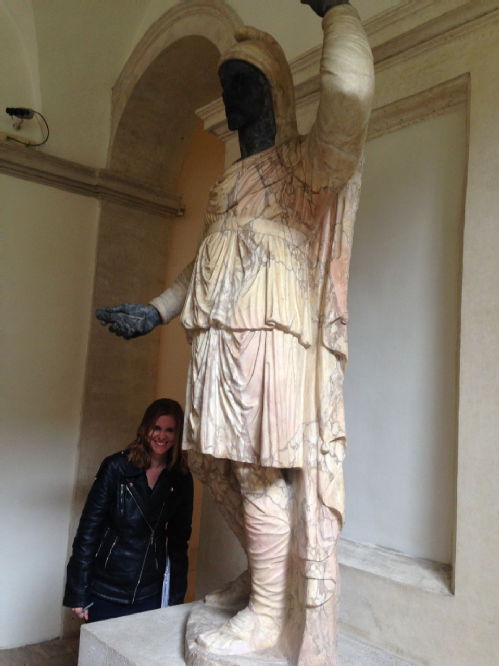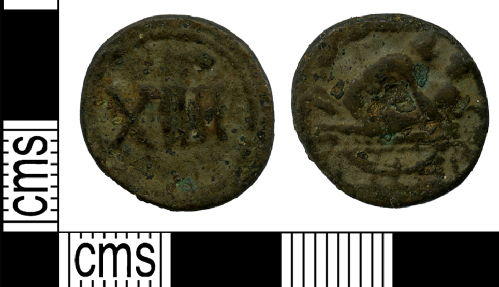All entries for Wednesday 01 June 2016
June 01, 2016
"Coins against Humanity"?
|
'Spintria' found in the Thames in 2012. PAS LON-E98F21 |
An Ancient Roman may not have been able to bring “Cards Against Humanity” to a pub game night, but they were able to bring spintriae. This particular sexy spintria was made famous when it was discovered in the Thames in 2012. There are several theories about the function of spintriae. People have suggested that they could be brothel tokens. Maybe the original owner of this token picked it up at the games? Or is it, as the title suggests, a game piece? One thing is for sure, the obverse is something that the user would remember and maybe even laugh at.
Two out of three theories are wrong. Suetonius wrote that Tiberius outlawed the use of coins stamped with the imperial image in bordellos (Clarke 1998: 244-245). This has led scholars to believe that these were brothel tokens. The idea that brothel customers would use these to pay for the services they wanted has been quickly dismissed (to see a more detailed discussion of this see Clare Rowan’s blog on this spintria).
This leads to the second theory. These tokens would be given to the public at public games. The idea this comes from a passage in Martial: “Now come sportive tokens (lasciva nomismata) in sudden showers.” (Martial Epigrams 8.78) These “sportive tokens” may be spintriae. That may seem like an odd token to give to spectators at public games celebrating things like military triumphs, but when considering the tensions in a society that placed importance on the lusts of men and the chastity of married women then maybe men receiving tokens to spend at a brothel might not be so bad (Knapp 2013: 236). However, this is not the case. The tokens would then be redeemed for gifts, but not at the local brothel. They could also provide a bit of a tough spot for an emperor who did not have the best press coverage. For example, viewers could be reminded of Tiberius’ sexual acts with boys on Capri (Suetonius Life of Tiberius 43-44). It is unlikely that an emperor, would want his people to snigger behind his back for what he got up to in his private life; thus, this theory seem implausible.
This leaves us with the third theory: these are game pieces. Although we don’t know what game these pieces were used with, we can be pretty sure that it was plenty of inspiration for the scenes of the game makers. There are other spintriae that have numbers going from I to XVI (1-16), but the sex scenes are different. This has led some scholars to believe that there is a correlation between the numbered spintriae and the illustrations of the sex manuals (Clarke 1998: 244, Clarke 2007: 194-5). This is also similar to the Pompeiian wall paintings found in the Suburban Baths. These are believed to have been numbered in a way similar to the lockers in the men’s changing room. As an added memory device, a taboo sex scene was placed above the number. The person using that space may not be able to remember his number, but they would probably be able to remember that funny dirty picture above it! (Savenga 2009).
This humour and function as a mnemonic device carried over to the game containing the spintriae. This spintria is tame compared to some of the other spintriae, so it was probably not one that was laughed too much. The steamy scene between this man and woman would have made the game memorable and may have reminded the player of what he had seen, read, heard, or even done. The fact that spintriae have been found in a widespread area, indicates that it Ancient Romans tended to have similar humour, played similar games, or that people loved this game so much that they brought it with them when travelling. Unfortunately, it may have been a male-only game. There were complaints [in Ancient Rome] that naughty pictures were corrupting respectable girls (Langlands 2006: 53). So, while the same sense of humour as a game of “Cards Against Humanity”, it might not have been a game to bring along to a game night with mixed company. However, it is not unreasonable to think that some clever minxes did manage to play “Coins Against Humanity”.

This month's blog was written by Katrina Anderson. Katrina is a Master’s student at Warwick University, who has recently become interested in the role of sex and gender in Ancient Roman art.
Bibliography
Clarke, J. (2007) Looking At Laughter. (London: University of California Press).
Clarke, J. (1998) Looking At Lovemaking. (London: University of California Press).
C. Rowan, Coins at Warwick: Ain’t talkin’ ‘bout love. Roman “Spintriae” in context.(1 Aug 2015). Accessed 10th May 2016.
Knapp, R. (2011) Invisible Romans. (London: Profile Books).
Langlands, R. (2006) Sexual Morality in Ancient Rome. (Cambridge: Cambridge University Press).
Martial, Epigrams, trans. Shackleton Bailey, D.R. (Cambridge, Mass.: Harvard University Press: 1993) 2 vols. from Loeb Classical Library.
Sayenga, K. Sex in the Ancient World: Prostitution in Pompeii, Documentary, directed by Kury Sayenga (2009; New York: History).
Suetonius, The Twelve Caesars, trans. J.C. Rolfe (London: William Heinemann: 1913) 1 vol. from Loeb Classical Library.

 Clare Rowan
Clare Rowan

 Please wait - comments are loading
Please wait - comments are loading

 Loading…
Loading…